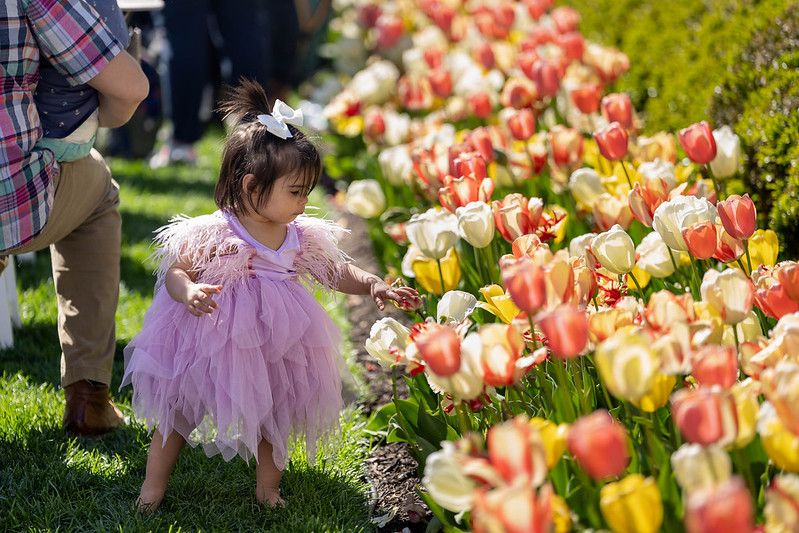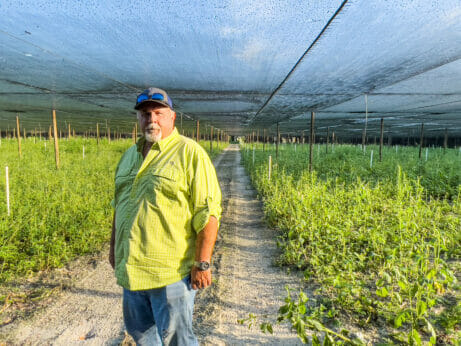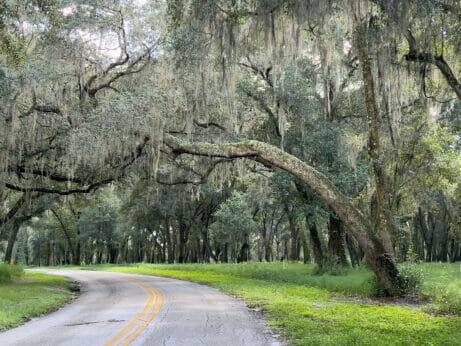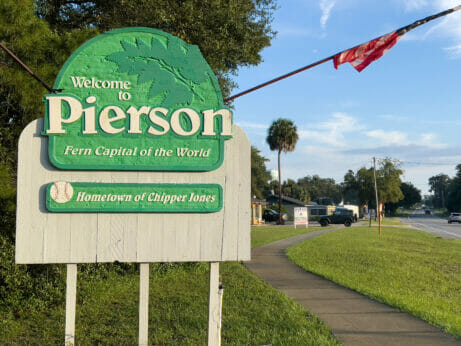Policies supporting imported flowers have undercut domestic flower and foliage farmers for decades. The First Lady’s Luncheon is one stop in a push to recultivate the value of American-grown floral products.

The early morning, late summer fog still clings to wide open grassy areas along a quiet stretch of US Highway 17. It’s where an oversized welcome sign to rural Pierson, Florida, flanked on each side with American flags, greets visitors right across from a local feed store. The sign, at the edge of the two-lane roadway, is the kind that sparks excitement (and relief) that this must be the place.
“Fern Capital of the World,” it reads. And below that another accolade: “Hometown of Chipper Jones,” a local boy who made it big, real big. Major League Baseball kind of big, with a near 20-year career with the Atlanta Braves and elected to the Hall of Fame. There’s a lot to be proud of in this farming community.
But it’s the locally grown foliage crop, especially the leatherleaf fern, that has put this region, dotted with ferneries, on the map. Just up the road in the town of Seville is David Register’s operation, FernTrust. In addition to leatherleaf fern, Register and his multi-generation family grows a variety of greenery — magnolia, aspidistra and tree fern among them. The products make up the base of arrangements, bouquets and other ornamental decor commonly used for all of life’s celebrations and ceremonies.
“I think the industry and the type of farming we do is unique,” Register told me. “It’s kind of like a mix between farming and art.”

David Register, executive vice president of FernTrust in Seville, Fla., stands under the shade cloth-covered grounds of his fernery. FernTrust is a sponsor of the First Lady’s Luncheon. (Photo: By Jennifer Taylor)
Recently, the foliage from this agricultural community has graced the tables of some of the most influential spouses in the country. Just this past spring, the greenery grown in this area’s ideal high, sandy soil, once again complemented other American-grown cut flowers from across the country in centerpieces and other decor at the distinguished gathering of the First Lady’s Luncheon. It’s a time-honored tradition in Washington, D.C. hosted by the Congressional Club and it’s where First Lady Dr. Jill Biden recently addressed congressional families. The club, established in 1908, is made up of spouses of members of Congress and was designed to help foster friendships among the legislative leaders. Annually, it honors the first lady and, in turn, she speaks before a bi-partisan crowd of influencers.
It’s also fertile ground for showcasing an industry desperately trying to recultivate the value of American-grown products in the wake of US policies supporting imported flowers that have undercut domestic flower and foliage farmers for decades.
“Our farms are so incredibly giving and supportive. And they’re so proud to see what is on the tables and what adorns the event. Because it’s a sense of pride for them,” says Camron King, CEO and ambassador for Certified American Grown, an independent national trade association that represents American cut flower and foliage and potted plant farmers. Members of CAG sponsor their time, travel expenses and the products that make up the floral arrangements for the First Lady’s Luncheon.
The hope, too, is to get the word out to lawmakers about the plight of American cut flowers and foliage growers.
The message hasn’t always been this urgent. Up until the early 1990s, most cut flowers and foliage sold in the United States were grown here. But federal trade agreements, such as the Andean Trade Preferences and Drug Eradication Act and the US–Colombia Trade Promotion Agreement, were implemented and supported by subsidies to foreign governments to plant flower fields instead of trading in drug manufacturing and trade. While well intended, critics say such decisions created a scenario where imported flowers and foliage could be sold in the US cheaper than what homegrown farms could produce and sell. Making matters worse, as the years went by, American flower and foliage farms began going out of business. Now, only about 22 percent of the flowers and foliage sold in the United States are grown here; the bulk is foreign grown and enters the country through Miami ports.
“We have the rose as the American flower. There’s only a small handful of American rose producers left because some of the decisions on the policy side that have been made have had negative effects in that roses are oftentimes imported. So it has major impacts, not just in economics, but also societally,” says King.

Fern fields grow under Live Oak tree hammocks in Seville, Fla. (Photo: Jennifer Taylor)
The US, according to CAG, has spent hundreds of millions of dollars to help grow the floral industries of other countries. For instance, in 2018, it was announced that the US would help Kenya double its floral exports to the United States. More recently, the United States Trade Representative office agreed to add roses to the list of products eligible from Ecuador to be shipped to the US duty free.
“The economic impact is huge and the quality of life impact is huge,” says King. Harvesting from the field or out of greenhouses and then bringing product to wholesalers and on to floral designers, for instance, is not only hands-on work but it literally passes through many hands and, in turn, touches many livelihoods.
“We want to ensure that we continue to move that forward, because it is a tradition and heritage that’s a fabric of American history,” says King.
To do so, CAG formed in 2021 to help educate consumers about the importance of buying American-grown cut flowers and foliage. The advocacy group is starting to make some headway.
For instance, the month of July for the past several years has been celebrated as American Grown Flower and Foliage month, supported with resolutions in both the US House and Senate. Consumers can select domestic products identified with the “Certified American Grown” seal. Even more important, the organization is expecting the American Grown Act will be reintroduced to Congress this year.
The act would require the White House, State Department and Department of Defense to only display American grown flowers and foliage. The intention, according to CAG, is to show support of the domestic growers, businesses, and communities by displaying products in offices, at functions and during ceremonies under the jurisdiction of the departments.

A welcome sign in Pierson, Florida, describes the community as the “Fern Capital of the World.” (Photo by Jennifer Taylor)
Erik Hagstrom is a fifth-generation fern and foliage farmer with Albin Hagstrom & Son and a CAG board member. His family farm is located not far from FernTrust and he shares similar concerns about the industry.
“If the federal government is going to spend money on product, it should be product that is grown right here in the United States,” says Hagstrom. “Our research has shown that people will certainly take something if it is grown here, versus grown in some other country that is not democratic. People enjoy seeing that. But the problem is that we’re such a small industry. Our voices just don’t get the resonance that you need to get it out there.”
That’s why, says King, the opportunity to participate in the First Lady’s Luncheon aligned with the advocacy group’s goals for its industry. “The Congressional Club is, much as we are with CAG, bipartisan,” notes King. “We use the chance to connect with spouses who obviously are relating directly with their spouses who may be seated members, or are seated members in such a way that we’re asking for further support and work to allay the prospects of what we’re doing.”
Back in central Florida, Register makes the morning rounds in his pickup truck, surveying the harvest and checking crops for disease. The fields are uniquely Floridian. Narrow unpaved roads wind under massive Live Oak tree hammocks that cast protective shade over varieties of fern and other foliage thriving on what looks like a forest floor. In other fields, the environment is manufactured. Tall wooden posts support large swaths of shade cloth where the leatherleaf fern grows, under a sometimes relentless sun, year-round.
King’s efforts in Washington haven’t gone unnoticed. Register, who also is a CAG board member representing the southeast, believes the association is providing an opportunity to help turn around the industry.
“I just want the American consumer to understand that American agriculture represents families just like mine,” says Register, whose daughter, Victoria, traveled to Washington to help set up a recent First Lady’s Luncheon. “When we source out to offshore, yeah, it’s maybe helping those people down there. But it’s not your American farm family. And if we want to keep agriculture in the United States, whether it be flowers, ferns, tomatoes, grapes, corn, whatever, we have to make it profitable for American farmers to do that.”
The leatherleaf is a deep green fern with a thick stem and glossy, fine lace-like fronds. When it adorns the luncheon tables it’s a piece of nature’s canvas that makes blooms pop. Inside the grand ballroom for the first lady’s event, King doesn’t expect the beauty and emotion that the arrangements evoke from attendees to fully translate into “buy American.”
But he does hope consumers start connecting the dots of where the flowers in floral shops and supermarkets come from. And that there are families like the Registers and Hagstroms and the families of their employees on down that depend on the growth of cut flowers and foliage.
The leatherleaf, Register knows, is the crop that pays the bills. But, to him, it’s so much more. As he spoke about his farm, he paused, as if a year flashed in front of him. The early fall is probably the worst time of year to look at the leatherleaf crop, he says. It’s just come off the heat of summer when the disease, fungus and weeds go crazy. It can be depressing. But, when spring arrives, he feels good taking something from almost nothing and seeing it thrive.
“I think it’s beautiful,” he says.
This story is adapted with permission from East Wing Magazine, a publication dedicated to covering presidential first ladies present and past.